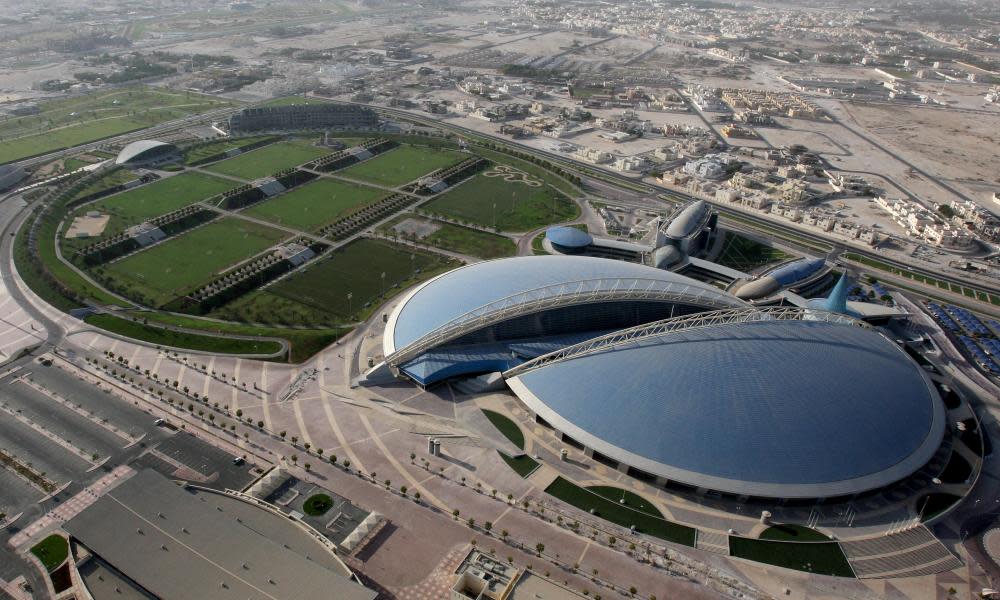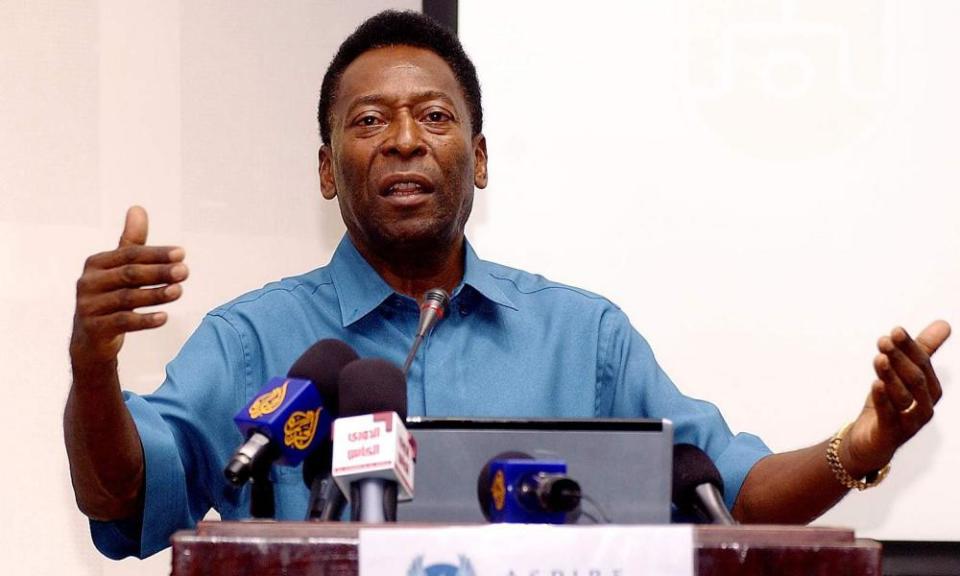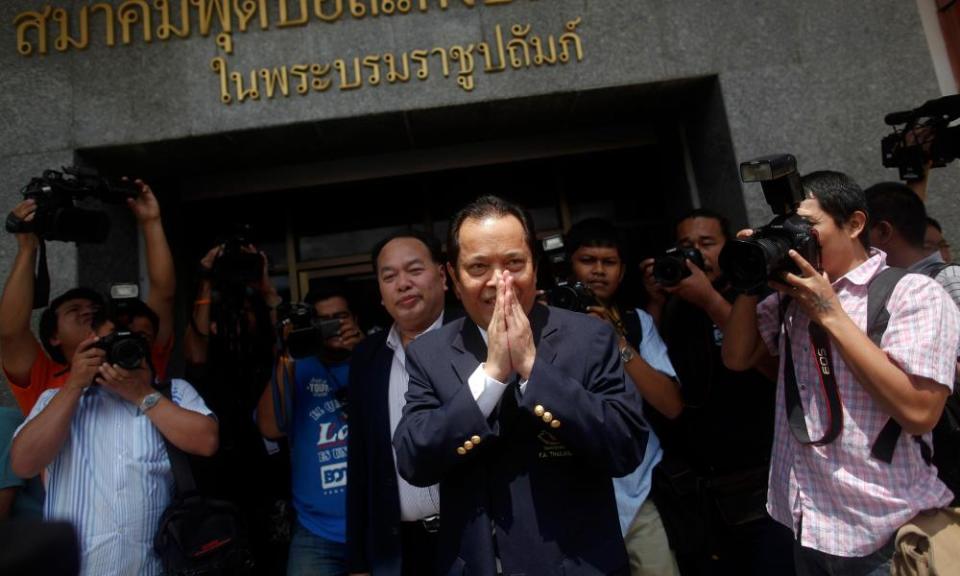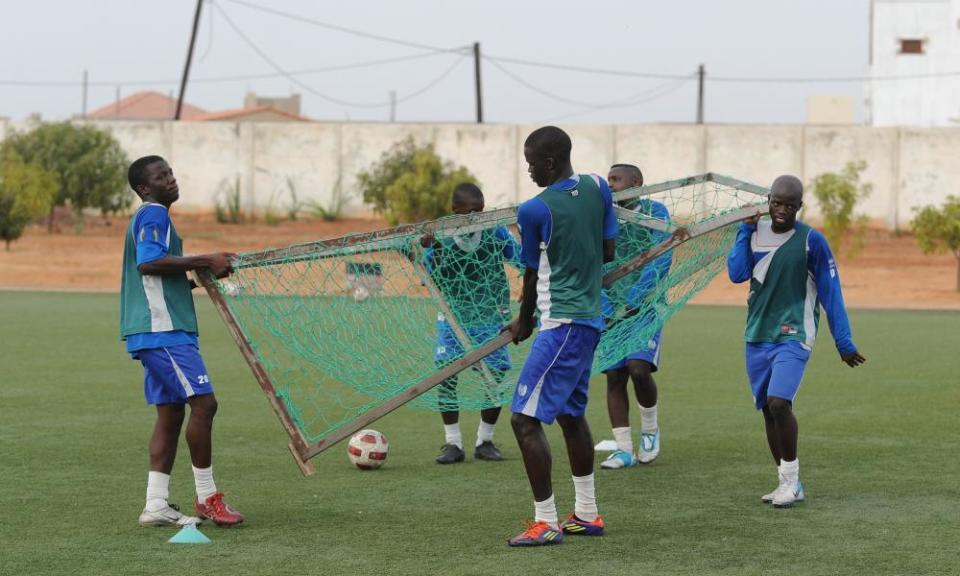Was Aspire project a vehicle to deliver votes to Qatar’s World Cup bid?

Look who we are, we are the dreamers. We make it happen. There is something seductively inane about the soundtrack to Qatar 2022, present in the slogans plastered across its surfaces, the sonic assault of the World Cup PA, the playlist of official anthems, centralised messages, approved corporate machine-feelings.
“Believing is magic” read the words across the back of the T-shirts worn by a column of men filing through the service exit of the vast fibreglass tent that is Al Bayt Stadium in the wee hours of Friday morning. The power of dreams. The power of football. The power of Football Dreams. What could ever be wrong with that?
Across a 12-year process that has generated so many inane slogans – so much love, so much tolerance – Football Dreams is probably the grand-daddy of them all. This was the name given to the outreach element of Qatar’s Aspire Academy during the early days of the baroque procurement process for this World Cup.
This is a World Cup like no other. For the last 12 years the Guardian has been reporting on the issues surrounding Qatar 2022, from corruption and human rights abuses to the treatment of migrant workers and discriminatory laws. The best of our journalism is gathered on our dedicated Qatar: Beyond the Football home page for those who want to go deeper into the issues beyond the pitch.
Guardian reporting goes far beyond what happens on the pitch. Support our investigative journalism today.
Football Dreams has been slightly lost in the years since, obscured by more immediate issues. But it is worth revisiting now, viewing with the facts laid over one another like an architect’s carbon drawings. A cold case, it makes for remarkable reading with what we know now. There are no smoking guns when it comes to why and how at Qatar 2022, just an endless plume of unexplained smoke. But here is a little more.
With hindsight Football Dreams was always a strange concept. At vast expense (is there another kind?) Qatar sent a team of elite football scouts on a series of people-hunting trips to 15 developing nations, touring villages in their column of SUVs, harvesting children for a Willy Wonka-style golden scholarship to the Aspire school and academy.
Between 2007 and 2014 Qatar screened more than 3.5 million 12- and 13-year-old boys. At its height Football Dreams had six thousand staff and volunteers. Out of this mass of hopeful humanity up to 20 Aspire scholarships were awarded each year, pathway to becoming a Champion In Sport or A Champion In Life (we are, and Qatar can’t emphasise this enough, The Dreamers).

The point of this process was never really clear beyond the messaging. Qatar called it “a humanitarian project”. Pelé lurked vaguely at the fringes. Towards the end there was some charitable work involving mosquito nets and a video that showed Lionel Messi looking worried about malaria. Some human rights bodies likened Football Dreams to people trafficking. Even Sepp Blatter called it “an exploitation” before abruptly changing his mind.
Looking back it seems like a strange and unworkable concept. From a blur of practice games in nations such as Guatemala and Vietnam Qatar planned to unearth star talent. Actual established professional academies spend years trying and failing to do this with endless monitoring and space to bloom late or fall away. Children are vulnerable beings. Sport is unforgiving. This thing, the footballing equivalent of game-hunting from your open helicopter bay door, was never going to work in any serious fashion.
The Dreams programme ran from 2007, plateaued after the winning bid and was shut down in 2014. But Aspire, its launchpad, remains key to Qatar’s sporting ambition.
The Aspire dome is a beautiful soft blue glass curve rising up out of Doha’s eastern suburbs like an igloo of the gods. Speakers pipe the sounds of birdsong across the wider Aspire Zone, which houses a full-size football pitch, accommodation, a school, an Olympic-scale swimming pool, sports science centres.
Chasing it down on foot past the vast craning Khalifa Stadium, following the line of the Italianate-themed shopping mall with indoor gondola lake, there is a familiar feeling of fruitless pursuit. That blue glass horizon peeps out through the gaps in the buildings like the sea over the crest of a hill, never really getting closer.
In the shadow of the Doha Torch, the dome finally reveals itself, the egg that hatched the World Cup. Witness Excitement reads a vast beige sign at the edge of the Zone. Except, there is no excitement here. On the morning after the Qatar national team’s World Cup ended in limp defeat to the Netherlands, the Aspire Zone is shuttered. For now any visible sign of Qatari Aspiration is on hold.
It should be said Aspire has been a great success on its own terms. The programme to create a Qatar national team was initially under the care of Sheikh Jassim bin Hamad al-Thani, a genuine football fanatic rumoured, as John McManus writes in his wonderful book Inside Qatar, to have suffered insomnia from watching so much football on the banks of screens in his bed chamber.
Qatar does not have an ingrained outdoor sporting culture. Even its winter heat is draining, creeping under your skin like a dose of flu. So Qatar built a kinder blue sky under its dome. Every kid with any kind of talent was enrolled and ranked and rated, the emphasis always on detecting elite potential.
It is an extreme version of the systems rolled out by the British Olympic programmes or Premier League academies. Sport for the few. Sport as entirely outcome-based, sport as an elite level gloss on a sedentary society.
Related: Infantino is the nowhere man in this bonfire of greed, vanity and despotic power | Barney Ronay
But it worked. Aspire graduates (this is misleading: every player here is an Aspire graduate. Where else are you going to train?) won age-group competitions and then the Asian Cup in 2019, sparking mass celebrations on the Corniche.
This process hit its outer limit in the last two weeks. Hundreds of millions of pounds in the making, every detail refined and finessed, Qatar’s footballers were the most feeble World Cup hosts in men’s tournament history. They had six shots on target. The players looked stunned by the glare. At times there was almost a sense of opponents going easy on them.
In a way it was apt. The Qatar team is essentially a construct, a slogan made flesh, an expert replica of a live sporting culture. It embodies brilliantly the question that hangs over so much at this World Cup. Is this actually real? Qatar wants a World Cup. Qatar wants a turn at the show. Today I feel like … a professional footballer.
But one thing is also clear. Qatar always has a plan. We are the dreamers. But we also make things happen. And this is where Football Dreams re-enters the Aspire picture. The dots have not really been joined. Let us join them here. This is no doubt unfortunate coincidence, yet another case of Qatar unfairly tainted by other people’s corruption. But here are some facts. Of the 15 countries awarded the Football Dreams mission, five were also the home nations of a Fifa executive committee (exco) member. Fifa exco members decide who gets to host a World Cup.
Some were a baffling fit for the programme. This issue floated up at the time and did not really go anywhere. It is mentioned in the Garcia report into Fifa corruption but was then largely lost in the fug. What Garcia did not know, as his report predated the key arrests and bans, is that all five of those Fifa exco members, the Football Dreams converts, have turned out to be demonstrably tainted by corruption. This fact has never really been adequately reverse-engineered into the Football Dreams puzzle. Exhuming its details now, this is what it looks like.
Worawi Makudi was a member of the Fifa exco. Qatar’s Football dreams programme came to his home nation Thailand. He voted in the Qatar World Cup bid. He was banned and fined in 2016 for forgery and falsification but the ban was overturned by Cas after the Thai’s criminal conviction was quashed.

Rafael Salguero was a member of the Fifa exco. Qatar’s football dreams programme came to his home nation Guatemala. He voted on the Qatar World Cup bid. He pleaded guilty in October 2016 to criminal conspiracy to commit bank fraud and launder money.
Amos Adamu was a member of the Fifa exco. Qatar’s Football Dream project came to his home nation Nigeria. Adamu did not even get to the start line in Zurich. He was suspended from the vote after apparently agreeing to take a bribe in a newspaper sting.
Issa Hayatou was a member of the Fifa exco. Qatar’s Football Dreams project came to his home nation Cameroon. He voted on the Qatar World Cup bid. Hayatou has been accused of, and firmly denied, allegations of corruption relating to the activities of Mohammed bin Hammam at Fifa.
Most startling of all, Fifa exco member Nicolás Leoz of Paraguay, who was instrumental in shepherding the South American bloc to vote for Qatar, has since been accused of taking bribes and assorted other nefarious practices, blame-loaded into the grave by his former colleagues. A Qatar Football Dreams project opened in Leoz’s home country shortly before the vote.
At the end of which we have a £100m programme that made little practical sense installing itself in a series of locations where football administration is governed by people who are with hindsight tainted by corruption; all of whom have a say on the success of Qatar’s 2022 World Cup vote.
There is no evidence that any of this is connected, or any undisputed evidence of unsound influence around votes cast for Qatar’s bid. But Garcia was already concerned about Aspire. The report states: “There is evidence that Qatar 2022 employed an entity that at least contemplated diverting Aspire resources to countries associated with Executive Committee members or otherwise using Aspire resources to influence those members.”
Related: Antoine Griezmann reiterates support for LGBTQ+ community
As Garcia notes, Football Dreams was run in its early stages by Sandro Rosell, who would later wire £2m to an account held by the 10-year‑old daughter of Ricardo Teixeira, a discredited Fifa exco member; payment that was, the relevant parties have insisted, “unrelated to Qatar’s World Cup bid”.
Garcia circles around a meeting in January 2010 at Itanhangá Golf club in Rio attended by the emir of Qatar plus Julio Grondona, Leoz, Teixeira and João Havelange, plus Aspire officials. The meeting was described by Qatar as “an opportunity for the charismatic and progressive Emir to meet the leaders of South American football”. Garcia accepts, as Qatar contends in its defence, that “the Emir is not bound by Fifa’s rules”. Which sounds, on the evidence of this World Cup, about right.

The Guardian tried to talk to Qatar’s Supreme Committee for Delivery & Legacy about Aspire, about these issues, about the successes and future direction of the programme, but nobody was able to reply to requests. Qatar has already had its say in response to Garcia. “In the upside down world where the Qatar Bid committee finds itself, the Aspire programme is now described by some media as using its influence in countries with Executive Committee members in order to improperly influence the outcome of the bid. This allegation is disproven by a neutral version of its history.”
What to make of all this now, as Qatar 2022 gallops on through its winter fever dream? As ever with Qatar it is useful to apply the filter of furiously literal-minded Qatari realpolitik. How do you get your hands on a World Cup? You give the world what it wants. OK. Let’s do that times a million, do it better than anyone else, do it better and more lavishly than, say, Australia, who also made entreaties towards Africa, or England, who seemed to think handbags would do the job. Lads, this is how you do it.
Qatar is like your no-filter friend who sees this stuff, the transactionalism, the commodification of human lives, the sharp edges of global capitalism, and strides straight through to its endpoint, without the elements in other cultures that soften or obscure this process. Want a World Cup? Here is a literal desert astro-turfing project, because this is how it works.
The Aspire dome sits at the centre of this thing, crouched behind its opaque reflective walls. The fields of its public zone are also empty. A massive frozen football screen displays a heap of broken images to no one. Wandering about this place there is a sense of the loneliness of the enterprise, the sheer force of will required to create this imagined world. Aspire will re-gear itself, will set its sights on securing the much-coveted Olympic Games. For now the deep green pitch beneath the mirrored dome is empty, the lights blazing down, a lone guard patrolling the centre, a place, still, of Football Dreams.

 Yahoo Movies
Yahoo Movies 
